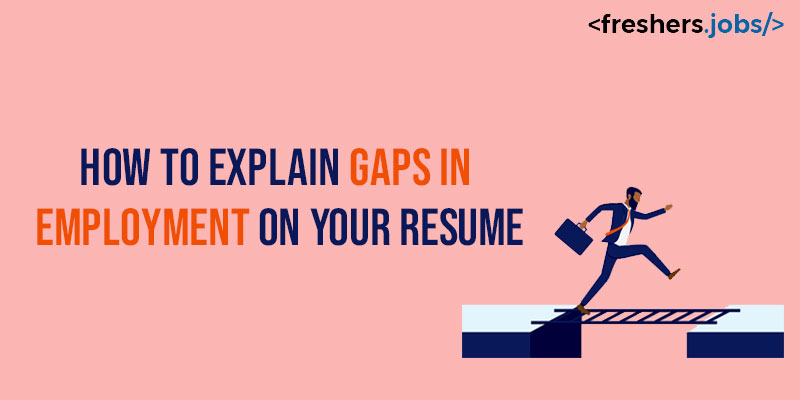It can be difficult to explain a break in jobs, but there are many good ways to do it. In this blog, we will explain word-for-word explanations of how to discuss the employment gap in career, on your resume and in your cover letter.

A recruiter will usually look at your resume to get their first impression of you. It’s important to discuss employment gaps in your resume to ensure they don’t hurt your image. You can make a great experience section on your resume if you know how to talk about employment gaps in a positive way. This blog tells you everything you need to know about explaining gaps in your work history, such as where to explain them and a list of good reasons in your resume and cover letter. To include it in your cover letter, you must know how to write a cover letter for a resume.
What do gaps in employment on resumes mean?
During your professional life, employment gaps are times when you don’t have a regular job. An employment gap can be anywhere from a few months to a few years long and can happen on purpose. The Employment gaps on a resume can be a cause for concern and the reason for employment gap is if you must explain carefully why you weren’t working and what you did during that time.
How to explain the employment gaps in your work history on your resume
Follow these steps and tips to explain why you have not worked for a while:
- Spend your time out of work getting ready to go back to work.
- Figure out what jobs you need to add.
- Try leaving out the month to cover up small gaps.
- Use a style or format for your resume that makes the gap less clear.
- Make the reason for longer gaps between jobs.
- Add any relevant experience you got during the break.
Spend your time out of work getting ready to go back to work
The first thing you should do to explain the reasons for gap in employment on your resume is to try to use your time away from work to get ready to go back to work. You can do this by using this time to improve your career, such as by getting industry-related certifications, taking continuing education classes, getting involved in professional groups, or doing volunteer or contract work to earn a good freshers salary. This can give you good experiences that you can put on your resume to fill in gaps between jobs.
Figure out what jobs you need to add
Next, you must decide if you must put your time between jobs on your resume. You don’t have to list every job you have ever had on your resume. If you are a professional with many years of experience and your employment gap happened early in your career, it may not be necessary to list the job you had before your gap. In general, in the “Employment” section of your resume, you should only list your most recent and most relevant jobs. You must be prepared with ways to find your next job.
Try leaving out the month to cover up small gaps.
Next, if the gaps in employment history are small and happen between jobs, you can hide them by leaving off the month from each job experience. Instead, just write down the years you worked at each job. But this way of covering up employment gaps on your resume usually only works well if the gaps you are trying to cover up are less than a year-long and you worked at each job for more than a year.
Use a style or format for your resume that makes the gap less clear
Next, you can use a style or format for your resume, like the functional resume format, to make job gaps look less obvious. In a functional resume format, your skills and accomplishments are more important than your work history. You can make the best parts of your experiences the main focus of your resume by putting them in sections like a career summary statement and key achievements. Then, put a section about your jobs at the end of your resume.
List the reason for longer gaps between jobs
How to fill in employment gaps on resumes? When you are out of work for a long time, you usually need to say more about it on your resume than when you worked for a short time. If you have worked for more than a year for a long time, it will still show up on your resume, even if you only list the years or use a functional resume format.
Add any relevant experience you got during the break
If you can make a connection between the experience you got during your gap in your career and the jobs alert you are applying for, it may help to give more details in your employment gap entry. You can give specific examples of daily tasks and responsibilities you had during the time you weren’t working that are relevant to the job you are applying for.
For example, if you have not worked for two years because you took time off for another work and are applying for a job as a nurse, you might write this in the employment gap section of your resume. Before you look for new jobs, research the company you are applying for.
Here’s a list of good reasons for job gaps
There can be reason for employment gap for both planned and unplanned reasons. If you have a job gap in your resume, you should try to give a good reason for it. There may be gaps in your work history for several good reasons, such as:
- The time it takes to look for a new freshers jobs.
- Being fired because of changes at the company.
- The time is taken to care for a child or parent at home.
- Taking a medical leave of absence.
- The time you spend getting a better education.
- Time spent getting certifications.
- Moving from one place to another. Using the gap years to improve yourself.
Most of the time, how you spend your time when you are out of work and how you explain your employment gap on your resume are more important than why you were out of work. So, when discussing employment gaps on your resume, try to focus on the good things you learned instead of the bad ones. As freshers, you must know the tips for writing subject for sending resume.
The time it takes to look for a new job
You should also know where to explain employment gap reasons and how to explain them. In general, you should talk about employment gaps in three places: your cover letter, your resume and an interview, if asked. There are ways to make employment gaps on your resume look less obvious, but it’s still important, to be honest about why you didn’t work for a longer time.
The cover letter of yours is a place to explain long breaks between jobs because it gives you space to explain in detail how you used your time off to get ready to go back to work. Explaining employment gaps in your cover letter and resume also shows recruiters and hiring managers that you are honest and trustworthy, which can help you stand out from other candidates. You must know how to write an email professionally.
Conclusion
I hope you are clear from the blog on how to explain the gap in career on your resume. Your cover letter won’t benefit much if you discuss your employment gaps or concentrate on your times of unemployment. In reality, this may put off employers who are looking for content that will catch their cautiousness and make them read the rest of the resume for a job opportunity. Depending on the details of the gap, there may occasionally be little to no way to avoid discussing it in a cover letter.



